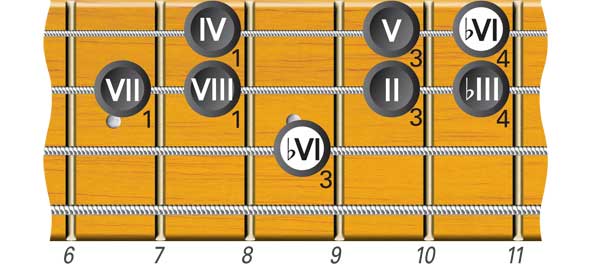
Harmonic Minor And The Modes
You have already learned the modes of the major scale. The sixth mode is called "aeolian", and is also referred to as the scale. The 3rd, 6th and 7th notes are all flattened, and the structural pattern T S T T S T T .
The harmonic minor scale (HM) is based upon the natural minor scale with the 7th note sharpened which is called a leading note. The harmonic minor note pattern is T S T T S T1/2 S. The principal of creating any modes is the same using a starting note and moving up in the scale until the octave is reached. Each mode is numbered with a Roman numeral, e.g., the 5th mode of the harmonic minor scale is labelled HM V. Some modes may have an additional name to describe its structure, e.g., HM IV could be called dorian #4.
There is at least one matching chord to each mode. All seven modes of the harmonic minor scale and their matching chords are listed here.
HM I (Harmonic Minor)

Example 285 illustrates the A harmonic minor scale with the note pattern:
T S T T S T1/2 S

HM II (Locrian 6)

The HM II is constructed by starting and finishing on the second note of the harmonic minor scale. This is shown in example 286 which begins with the second note of the A harmonic minor scale (B) and finishes one octave higher. The note pattern is
S T T S T1/2 S T

HM III (Major #5)

The HM III is constructed by starting and finishing on the third note of the A harmonic minor scale, the C note in the given example. The note pattern is
T T S T1/2 S T S

HM IV (Dorian #4)

The HM IV is constructed by starting and finishing on the fourth note of the A harmonic minor scale, the D note in the given example. The note pattern is
T S T½ S T S T

HM V (Mixolydian b2, b6)

The HM V is constructed by starting and finishing on the fifth note of the A harmonic minor scale, the E note in the given example. The note pattern is
S T1/2 S T S T T

HM VI (Lydian #2)

The HM VI is constructed by starting and finishing on the sixth note of the A harmonic minor scale, the F note in the given example. The note pattern is
T1/2 S T S T T S

HM VII

The HM VII is constructed by starting and finishing on the seventh note of the A harmonic minor scale, the G note in the given example. The note pattern is
S T S T T S T1/2
